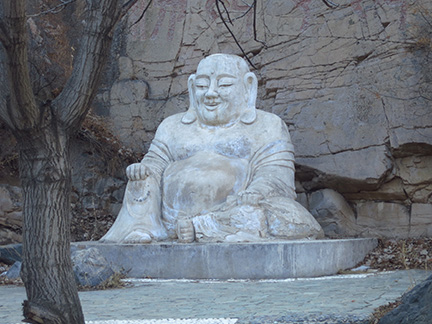 The seeker trudges slowly up the mountain through the mists, not sure which path to take. He takes one path only to find that it dead-ends around a few large trees, forcing him to go back and take a different route. The weather, as he rises higher, becomes colder and the rains icier as the storm worsens. He looks in vain for a place of refuge, a safe place protected from the harshness of the mountainside. Hours feel like days as he trudges through violent weather and bitter cold. The seeker finally finds himself before a cave. He bends low and enters.
The seeker trudges slowly up the mountain through the mists, not sure which path to take. He takes one path only to find that it dead-ends around a few large trees, forcing him to go back and take a different route. The weather, as he rises higher, becomes colder and the rains icier as the storm worsens. He looks in vain for a place of refuge, a safe place protected from the harshness of the mountainside. Hours feel like days as he trudges through violent weather and bitter cold. The seeker finally finds himself before a cave. He bends low and enters.
Inside, the cave opens into a large room. It’s clear from the old fire pit in the center that he is not the first to find this shelter. On the far left there is a large flat rectangular rock against the cave wall. On top of it is another rock, a meter high or so, a pedestal for a roughly carved likeness of Gautama Buddha sitting in meditation. Strewn on the cave floor near the fire pit are a variety of flat rocks, each of different widths, heights, and shapes and each forming a convenient seat. The seeker sits on one of the rocks, his legs crossed, and breathes slowly and deeply. He struggles to still his mind but more the more he tries the harder it becomes. Safe from the struggle of his trek up the mountains, surrounded by the turbulence of the alpine weather, he now finds himself struggling with the turbulence of his own life, his regrets, his yearnings and desires, his past. In his mind he relives all the tragic mistakes he’s made. Tears flow and sobs erupt as he succumbs to the horrors of his life.
Such is the nature of Zen practice. Behind the façade of the peaceful meditation hall is a place where each of us can tackle our inner storms. It’s a place of quiet where our entire being can be explored. And, just as a lengthy hike in the mountains exposes the beauty of the wilderness, it also reveals the dangers that reside there. It’s not possible to look deeply into ourselves without encountering the “worst” with the “best”, without confronting our demons. If we refuse to look into the dark and treacherous crevices in our psyche, we will continue to live in delusion.
The core part of our practice as Buddhists is to ban delusion from our lives. Living in truth is what brings the understanding and wisdom that leads to freedom. The first step is to begin the climb up the mountain. As we go, we encounter storms and pass through them, each time ascending higher.
This is, of course, a metaphor for Chan practice. True refuge is in our own mind. When we enter the meditation hall to seek refuge in the Three Jewels of Buddha, Dharma and Sangha, it will mean nothing unless we apply our heart and soul to the process of spiritual growth. We must do our part. On it’s own, the triple refuge is only a symbolic refuge, of no use at all without the effort we must put into diligent practice. It’s best to look at Chan practice as an opportunity rather than a solution. Once out of the storms and hassles of everyday life we have the opportunity to address what we are often too stressed to otherwise deal with.
Vanquishing delusion, we can see the truth that is left behind. If we practice honestly, we will find that true refuge is in our mind, not in some physical place. The meditation hall, like the cave, is no refuge at all, just a portal to the true refuge which is, and always has been, “closer than our life’s vein.”*
* Quran, Surah 50. Qaf, Ayah16
